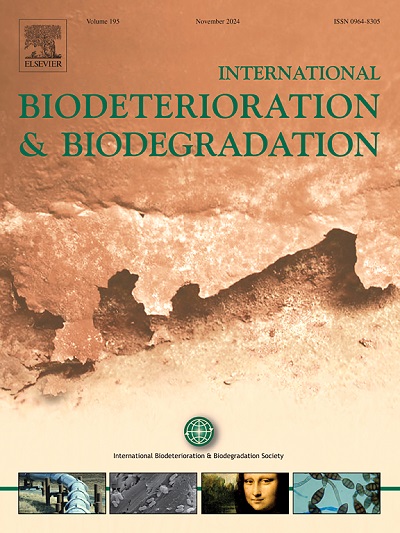植物激素诱导微藻系统对水产养殖废水中抗生素及耐药基因的强化去除
IF 4.1
2区 环境科学与生态学
Q2 BIOTECHNOLOGY & APPLIED MICROBIOLOGY
International Biodeterioration & Biodegradation
Pub Date : 2025-03-01
DOI:10.1016/j.ibiod.2025.106045
引用次数: 0
摘要
本研究创新性地研究了外源性异曲孤内酯(GR24)添加对常规营养物、代表性抗生素(包括四环素类(盐酸多西环素和盐酸四环素)、喹诺酮类(环丙沙星和诺氟沙星)、磺胺类(磺胺嘧啶、磺胺甲恶唑和磺胺甲恶唑)去除的影响。利用由普通小球藻(Chlorella vulgaris) + S395-2 +玫瑰绿球藻(Clonostachys rosea)组成的共生系统,从水产养殖废水中提取抗生素抗性基因(ARGs)。结果表明,GR24的最佳浓度为10 ~ 9 m,在此浓度下,共生系统的生长和光合效率均有所提高。对四环素类抗生素的去除效果最好。总磷、总氮和化学需氧量的去除率分别为84.18%±8.26%、82.24%±8.13%和78.25%±7.63%。对sul2、inti1等耐药基因的去除效率高,回弹慢。本研究为水产养殖废水的高效处理提供了新的途径,有助于减少污染,保护水体生态系统,促进水产养殖业的可持续发展。本文章由计算机程序翻译,如有差异,请以英文原文为准。

Enhanced antibiotics and antibiotics resistance genes removal from aquaculture wastewater by microalgae-based system induced with plant hormones
This study innovatively investigated the impact of exogenous strigolactone (GR24) addition on the removal of conventional nutrients, representative antibiotics (including tetracyclines (doxycycline hydrochloride and tetracycline hydrochloride), quinolones (ciprofloxacin and norfloxacin), and sulfonamides (sulfadiazine, sulfamethoxazole, and sulfamethoxazole)), and antibiotic resistance genes (ARGs) from aquaculture wastewater using a symbiotic system comprising Chlorella vulgaris (C. vulgaris) + S395-2 + Clonostachys rosea (C. rosea). The results showed that the optimal GR24 concentration was 10−9 M. At this concentration, the growth and photosynthetic efficiency of the symbiotic system were enhanced. It had the best removal effect on tetracycline antibiotics. The removal rates of total phosphorus, total nitrogen, and chemical oxygen demand reached 84.18% ± 8.26%, 82.24% ± 8.13%, and 78.25% ± 7.63%, respectively. Moreover, it had high removal efficiency and slow rebound for antibiotic resistance genes such as sul2 and inti1. This research provides a new approach for the efficient treatment of aquaculture wastewater, contributing to pollution reduction, water ecosystem protection, and the sustainable development of the aquaculture industry.
求助全文
通过发布文献求助,成功后即可免费获取论文全文。
去求助
来源期刊
CiteScore
9.60
自引率
10.40%
发文量
107
审稿时长
21 days
期刊介绍:
International Biodeterioration and Biodegradation publishes original research papers and reviews on the biological causes of deterioration or degradation.

 求助内容:
求助内容: 应助结果提醒方式:
应助结果提醒方式:


